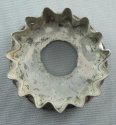Blender, Pastry
| Nom de l'objet : | Blender, Pastry |
| Matériaux : | tin |
| Numéro d'accession : | BE2009.1.296 |
| Date de début de production : | 1900 |
| Date de fin de production : | 1920 |
| Description : | A round tin cookie cutter with serrated edge. It has a 2 cm wide hole in the middle that perhaps once had a wooden handle fitted into it . |
| Fonctions : | The first evidence of cookie or pastry cutters were found in Mesopotamia and Egypt were in the form of ceramic moulds. There were also illustrations showing people making pastries using round cutters. The use of wooden stamp cutting moulds were popular in Germany during the Late Middle Age period and eventually made their way across North America during European settlement. The first printed reference to scones was in 1513 from a Scottish poet. They resemble the ancient Welsh tradition of cooking leavened breaks, or small round yeast cakes. The earliest scones were made with oats and shaped into a large round cake and later scored into wedges. They would be then baked on a griddle over an open fire. (Some information found from 'A short history of cookie cutters' by Silvana de Soissons www.silvanadesoissons.com/short-history-cookie-cutters/ and 'The History of Scones' www.thenibble.com/revoews/,aom/breadstuff/scone-history.asp). Item most likely used by either Naomi or Mary Harris. Although the Harris family had help for general domestic duties of cleaning and cooking the Harris women were very active in kitchen and enjoyed making pastries and collecting recipes. |
| Établissement : |
Museums of Mississauga
 Facebook-Museums of Mississauga Facebook-Museums of Mississauga
 Twitter-Museums of Mississauga Twitter-Museums of Mississauga
 YouTube-Museums of Mississauga YouTube-Museums of Mississauga
|
| Ville de l'établissement : | Mississauga |
| Province de l'établissement : | Ontario |
Coordonnées de cette page web
-
Pour proposer des corrections ou des mises à jour sur cette page, veuillez contacter directement le Réseau canadien d’information sur le patrimoine (RCIP).
